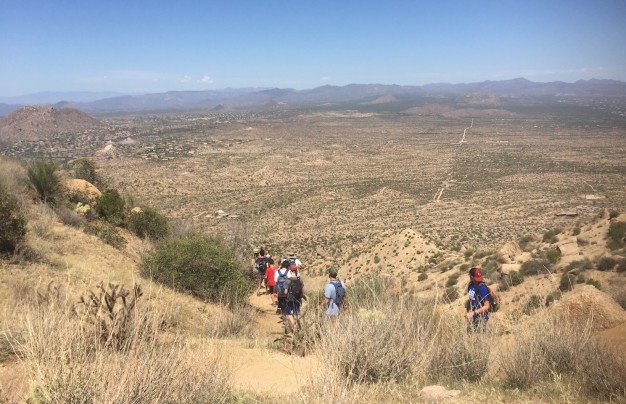

Hiking with the Monastics
On weekdays, I teach history to teenagers. On weekends, sometimes we go on hikes. We live in Arizona. Hiking trails here are dry and stark, scattered with sharp plants and hidden nests of snakes, and there is hardly any shade. If we don’t bring enough water, we may die. Seeing my students in the sunlight—sometimes excitedly scrambling over rocks, sometimes sitting, discouraged, under an outcrop—has helped me know and love them better. It has also made me a better teacher. We just finished a unit on Saint Benedict and the desert fathers, and now we are hiking uphill toward a rock formation known as Tom’s Thumb. We are practicing what these monks also did—retreat and return.
When Saint Benedict crawled into a cave to pray during the darkest days of barbarian-sacked Rome, he did not know that his book, The Rule of St. Benedict, would someday fall into the hands of 21st-century middle school students. But this work, which was greatly inspired by the earlier desert fathers, is a prime example of retreat and return, which Timothy Ware describes in his book, The Orthodox Church:
“In most of [the desert fathers] the same outward pattern of events is found—a withdrawal in order to return. A monk must first withdraw, and in silence must learn the truth about himself and God. Then, after this long and rigorous preparation in solitude, having gained the gifts of discernment which are required of an elder, he can open the door of his cell and admit the world from which formerly he fled.” (40)
Out of the solitude of these almost-ancient men grew a wisdom that returned to the world—a wisdom much like the Saguaro cactus, which can outlive a human being and can grow anywhere in Arizona, from the barren wasteland to an urban Phoenix neighborhood. This is the paradox of the monastic, and of the layperson who desires to live like one: we must both go away and return, be alone and be together, be in but not of this world.
One of my seventh graders didn’t bring enough food on the hike. His face is red and we sit under a bush, which is as close as we can get to shade. I give him some of my water and we sit, looking at the valley, not talking for at least fifteen minutes. The rest of the team is out of sight by now. We can turn around if you need to, I tell him. No way, he says; I can do this. We sit for a while longer, and I pray silently for no heat stroke today. Eventually he stands up and we make it to the top of the mountain. Later that year, whenever we see each other in the hallway, we will acknowledge each other, even just nodding, knowing we briefly were in the desert together, not talking.
“Apply yourself to silence,” says an anonymous desert father in Thomas Merton’s book The Wisdom of the Desert. “Be intent in your meditation, whether you sit at prayer, or whether you rise up to work in the fear of God. If you do these things, you will not have to fear the attacks of the evil ones” (47).
If retreat is about prayer, work, and solitude, then what is return? This is something I am still considering. What I do know is that we return from these quiet places changed. Some of these quiet places are literal, others spiritual. But when we go back to our jobs, our homes, our routines, how have these retreats changed us?
Two of my eighth graders are afraid of heights. We are on the last leg of the hike, and we are passing through a cave now, crossing over rocks with thirty-foot drops in between, and we can hear the rest of our team shouting excitedly at us from the exit of the cave on the other side. Hey, Ms. Brown! We could come live out here as monks, one of them suggests. But my two eighth graders are scrambling down a rock toward the exit, trying not to rip their shorts. We are all tense, but resolute, and we are almost there. When we step back out into the sunlight, we finally see Tom’s Thumb, that finger-shaped spire that has been our goal. We run uphill, all our energy returned to us, and touch the thumb with our fingertips.
For most of us, retreat and return do not happen only once in sequence. They may happen over and over again. They may happen simultaneously. Retreat and return may involve our bodies and minds, or perhaps our emotions, and certainly our spirits. When I look around at this desert where I work, and pray, and teach, and live, I ask myself, in which stage am I? All I know is I am in the middle of this, both alone and not alone, and I am learning when to speak and when to let the silence make me someday wise.
Betsy K. Brown is a writer and teacher who lives in Arizona. She received her Master of Fine Arts in creative writing from Seattle Pacific University, and is a parishioner at Christ Church.
This article was originally published on the Art House America blog and is reprinted here with permission.
